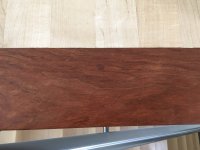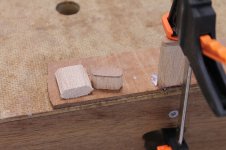I'm about finished building a rather complicated walnut chair and foolishly mortised 3 dominos on the wrong side of one of the chair legs. The legs are 8/4 stock and already joined to the arm rest and other leg and splayed so I really don't want to track down more 8/4 stock and rebuild one entire side of the chair.
I'm pretty frustrated with my stupidity, but trying to tell myself if I clean it up properly it could just look like a through-tenon on that side. The mortises are for the 6x40mm domino and I have some scrap walnut from the project around that I'm trying to use to make walnut domino plugs, but I don't have a router table to round them over or a chisel to square up the mortises. I've cut some scraps down to the corresponding domino size, but wondering if I should try to handheld route each side with my 1/4" round-over bit (which would require creating some sort of balancing jig for how thin the stock is) or if I should track down a tiny chisel to square up the mortises?
Thanks for any suggestions!
I'm pretty frustrated with my stupidity, but trying to tell myself if I clean it up properly it could just look like a through-tenon on that side. The mortises are for the 6x40mm domino and I have some scrap walnut from the project around that I'm trying to use to make walnut domino plugs, but I don't have a router table to round them over or a chisel to square up the mortises. I've cut some scraps down to the corresponding domino size, but wondering if I should try to handheld route each side with my 1/4" round-over bit (which would require creating some sort of balancing jig for how thin the stock is) or if I should track down a tiny chisel to square up the mortises?
Thanks for any suggestions!



![20190218_092607[1].jpg](/data/attachments/48/48256-c75b5d5971610744f54e2753ae080e11.jpg?hash=YWwYZf64IR)
